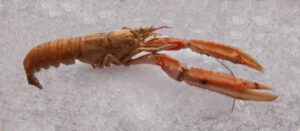Axiidae Family of Mud Shrimp
 Keeled Mud Lobster, Calocarides quinqueseriatus. A representative of the Axiidae Family of Burrowing Shrimp, Ghost Shrimp and Mud Shrimp.
Keeled Mud Lobster, Calocarides quinqueseriatus. A representative of the Axiidae Family of Burrowing Shrimp, Ghost Shrimp and Mud Shrimp.
Phylogeny: The Axiids are a member of the Axiidae Family of Burrowing Shrimp, Ghost Shrimp and Mud Shrimp in the Phylum Arthropoda. They are distantly related to true shrimp. There are currently one hundred global members of the Axiidae Family. They are in the Class Malacostraca and Order Decapoda.
Morphology: Axiids have a shrimp-like body with an extended abdomen and a large abdominal pleura. Their head has six segments, the thorax eight segments, the abdomen six segments, they possess antennules, antennae, compound stalked or sessile eyes and mouth parts; they usually have eight pairs of thoracic legs. The front three pairs of legs (maxillipeds) function as mouth parts. And one pair (chelipeds) serve as enlarged pincers or claws. The rostrum is, at least, twice as long as it is wide, with five or six “teeth” on each side. The first two pairs of legs have pincers (chelae), and the remaining three pairs are simple. They have well developed tail fax utilized for swimming. The largest species in the Family is 35 cm (14 inches) in length. Axiids may be white, red, pink, orange, or brown in color.
Distribution: Axiids are found in all global oceans except they are absent from the polar seas and are most abundant in the tropics and subtropics. Some are found in protected bays and estuaries, while others are found in the open ocean. They are found from the intertidal zone to depths of greater than 2,000 m (6,560 feet), though the great majority are found in water less than 183 m (600 feet). Axiids are found on soft substrates within burrows that may be simple “U” shaped tunnels, intricately branched tunnels or caverns. There are five Axiids found along the Pacific Coast of Mexico,.
Ecosystem Roles: Axiids feed primarily on plant material that is found either in the form of detritus or is suspended in the water column. In turn they are preyed up on shore birds, fish, and octopus. Axiids are often utilized as fish bait and larger ones are often eaten by humans.